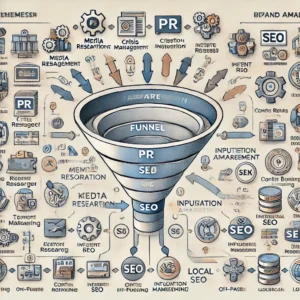PR & SEO Funnels That Will Maximize Conversions

Maximize Conversions with PR and SEO Funnels:
To achieve higher conversion rates, it’s essential to align the content with media coverage.
This synergy between content and media not only influences search behavior but also creates a strategic funnel, guiding users from media exposure to the website and ultimately leading to conversions.
When combined with a digital PR strategy, SEO and content marketing deliver the best conversion rates and most qualified leads.
By creating PR & SEO funnels, optimize the marketing efforts and drive better results.
Here are three key strategies to create an integrated PR & SEO funnel that can significantly boost the success:
Integrated Digital PR and SEO
Combining digital PR with SEO ensures consistent messaging, guiding potential customers from initial media exposure to website engagement and eventual conversion.
This integrated approach not only enhances visibility but also increases the likelihood of converting visitors into leads.
Funnel Optimization Strategies:
Branded Reports for Media Coverage and Web Traffic:
Create branded reports that attract media attention and drive traffic to the website.
By owning a “state of the industry” report or developing a study with a unique brand name, build a funnel that takes users from media mentions to search engines and finally to the website.
Guides in New Market Categories:
Establish the authority in a new market category by creating comprehensive guides.
This strategy, known as “category design,” involves leading and dominating a niche market with foundational content. Use digital PR to drive interest and demand, and rank for the new category’s keywords.
Feature Articles and Homepage Optimization:
Securing feature articles that align with the homepage messaging can significantly enhance the funnel.
When readers search for the brand after encountering a feature article, optimized homepage content can guide them further down the funnel towards conversion.
Align the homepage messaging with the narrative in the feature articles to create a seamless transition from media to conversion.
Success Case Studies
This article will highlight successful case studies like HubSpot’s annual marketing report and Drift’s conversational marketing platform.
These examples demonstrate how targeted content and strategic media coverage can significantly increase traffic and conversions.
Optimizing Content for Digital PR
To optimize content for digital PR, create consistent messaging that guides the audience from media exposure through search engines and to specific web pages for conversion.
Media coverage sits at the top of the funnel, driving interest and demand.
Develop an industry trend report that highlights key opportunities or pain points for the audience. Media loves data, so these reports can gain extensive coverage.
This coverage then drives searches for owned keywords, such as the brand or product names, new concepts, or specific high-value keywords.
Keywords related to the brand can have a click-through rate (CTR) of up to 60%, with audiences more willing to provide contact information or engage with the content.
Implementing the Strategies
Instead of simply describing how to optimize content for these funnels, let’s explore some practical examples:
Branded Reports for Data Shares:
Optimize the report’s name and promote it through a digital PR campaign.
By owning the “state of industry” report or creating a branded study, establish a funnel from media exposure to search engines and finally to website conversion.
Guides in a New Category:
Create foundational content that ranks in search engines for a new category name. Use digital PR to build demand and interest in the category.
Homepage Optimization for Feature Articles:
Align feature articles with homepage messaging to create a cohesive funnel. When audiences search for the brand after reading a feature article, they should find content that resonates and encourages conversion.
Integrating digital PR with SEO can transform the content marketing strategies, resulting in increased visibility, higher traffic, and improved conversion rates. By aligning content with media coverage through branded reports, innovative category guides, and strategically placed feature articles, significantly influence audience behavior and drive meaningful engagement and growth.
Implementing these strategies can elevate the digital marketing efforts and create a powerful PR & SEO funnel that leads to sustained success.
